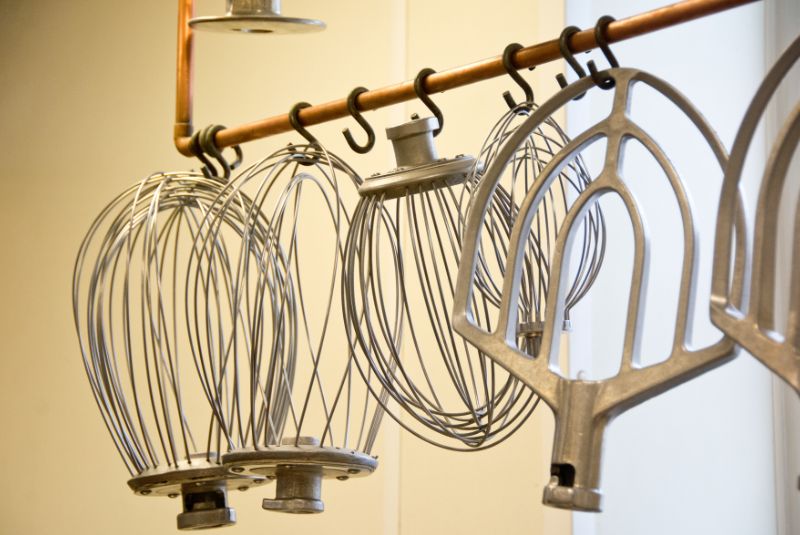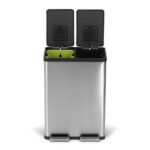The step-by-step guide “How to choose the right attachments for a stand mixer?” offers essential tips to help users select the appropriate attachments for their stand mixer. By following the guide, users can maximize the versatility and functions of their stand mixer effectively.
Understand Your Mixer
Research the brand and model of your stand mixer. Look for the specific information on the manufacturer’s website or refer to the user manual that came with your mixer. Understanding the brand and model ensures you have the correct information regarding attachments and compatibility.
Refer to the user manual or manufacturer’s website to identify which attachments are compatible with your stand mixer. Make a list of the attachments you currently have and cross-reference them to ensure they are suitable for your model. If you are missing any attachments, consider purchasing them from the manufacturer to expand the functionality of your stand mixer. Understanding your mixer’s compatible attachments will help you make the most out of your appliance and enhance your cooking and baking experience.
[content-egg-block modules=AmazonNoApi template=offers_list groups=”Step1″ hide=rating]
Identify Your Needs
Consider the type of cooking or baking you do most frequently. Evaluate the recipes you make regularly and think about the kitchen tasks that are involved. Identify which attachments would streamline these tasks and help improve the quality of your dishes. For example, if you bake a lot of bread, a dough hook attachment for your stand mixer can be a game-changer in kneading and proofing dough efficiently. If you frequently make pasta from scratch, a pasta maker attachment would save you time and effort.
Determine which attachments would enhance your recipes and make your kitchen tasks more efficient. Reflect on the specific needs of your cooking or baking style. If you often whip up soups and smoothies, a high-speed blender attachment could be a valuable addition. For those who enjoy making fresh juices, a juicer attachment would be a practical choice. By identifying the attachments that align with your cooking habits, you can optimize your kitchen workflow and elevate your culinary creations with ease.
Research Available Attachments
- Research your specific stand mixer model to find the range of attachments available. Check the manufacturer’s website or visit a store that sells your mixer to see the full selection of attachments compatible with your model.
- Evaluate your cooking and baking needs to determine which attachments would be most beneficial for you. Consider attachments such as pasta makers, food grinders, or vegetable spiralizers to expand the functionality of your stand mixer and streamline your food preparation process.
Check for Compatibility
- Check the size and model specifications of your stand mixer to ensure compatibility with attachments. Refer to the manufacturer’s guidelines for precise details.
- Measure the dimensions of your stand mixer’s attachment hub to confirm that attachments will fit securely.
Make sure to:
- Review the specific compatibility information provided for each attachment you are considering.
- Contact the manufacturer directly for any clarification on compatibility concerns.
- Avoid purchasing attachments that do not meet the specified size or model requirements.
- Test the attachment on your stand mixer before fully committing to ensure a proper fit.
Read Reviews and Recommendations
Before making a final decision, read reviews from other users to understand the performance and durability of the attachments you are considering. This step is crucial in ensuring that you choose attachments that will meet your needs and expectations. Here’s how you can effectively use reviews and recommendations to make an informed decision:
- Check for Consensus: Look for patterns in the reviews. If multiple users mention the same positive or negative aspects, it’s likely a reliable indicator of the attachment’s quality.
- Consider Long-Term Use: Pay attention to reviews that discuss the longevity of the attachments. You want to invest in products that will serve you well over time.
- Engage with the Community: Seek recommendations from fellow cooks or online communities. They can provide valuable insights based on their experiences and expertise.
- Ask Specific Questions: If you have doubts or need further clarification, don’t hesitate to ask for recommendations tailored to your specific needs.
Reading reviews and seeking recommendations is an effective way to gather firsthand information about the attachments you are interested in. By taking the time to research and listen to the experiences of others, you can make a more informed decision that will ultimately lead to a better cooking experience.
[content-egg-block template=offers_grid]
Making Your Decision
Great job on summarizing the key points of the blog post in the conclusion! It nicely wraps up the information and leaves readers with a clear takeaway. Well done!
Essential Supplies
[content-egg-block modules=AmazonNoApi template=offers_list groups=”Materials”]
Attachment Selection Guide
Operating your Stand Mixer
- Ensure the stand mixer is securely placed on a stable surface before use
- Attach the desired mixing attachment (whisk, paddle, dough hook) according to the recipe you are following
- Start the stand mixer on a low speed setting to prevent splattering, gradually increasing speed as needed
- Scrape down the sides of the mixing bowl with a spatula periodically to ensure all ingredients are well combined
- Turn off the stand mixer and unplug it from the power source before removing the mixing attachment or cleaning the appliance
Common Questions about Stand Mixers
Yes, a stand mixer can knead bread dough effectively. Stand mixers are designed with a dough hook attachment that is specifically meant for kneading bread dough. The powerful motor and consistent speed of a stand mixer can help develop gluten in the dough more efficiently than kneading by hand. This results in well-mixed and properly developed bread dough. So, if you’re looking to make bread at home, a stand mixer can be a very effective tool for kneading the dough.
When purchasing a stand mixer, there are several key features you should consider:
- Power: Look for a stand mixer with a powerful motor, typically measured in watts. This will determine how well it can handle heavy mixing tasks.
- Capacity: Consider the size of the mixing bowl. Stand mixers come in various bowl sizes, so choose one that suits your needs, whether you’re baking for a small family or a large gathering.
- Speed settings: Make sure the mixer has multiple speed settings to give you control over the mixing process. Different speeds are suitable for various mixing tasks.
- Attachments: Check what attachments come with the stand mixer. Common attachments include a whisk, paddle, and dough hook. Some models offer additional attachments for more versatility.
- Tilt-head vs. bowl-lift design: Stand mixers come in tilt-head or bowl-lift designs. Tilt-head models are easier to use and store, while bowl-lift models are typically more stable for heavy mixing.
- Durability: Look for a stand mixer made of high-quality materials that will last through many baking sessions.
By considering these features, you can choose a stand mixer that best fits your baking needs and preferences.
To clean and maintain a stand mixer, start by unplugging it and removing any attachments. Wash the attachments in warm, soapy water and dry thoroughly. Wipe down the stand mixer with a damp cloth, paying special attention to any crevices or grooves where food may hide. Avoid submerging the stand mixer in water to prevent damage to the motor. To maintain your stand mixer, periodically check the beater blade alignment and tighten any loose screws. Lubricate any moving parts as needed according to the manufacturer’s instructions. Lastly, store your stand mixer in a clean, dry place with all attachments organized to prevent damage and ensure it’s ready for your next use.
Using a stand mixer has several advantages. It can save you time and effort in the kitchen by mixing ingredients more efficiently and thoroughly than hand mixing. Stand mixers also have various speed settings and attachments that allow you to handle a wide range of tasks like kneading dough, whipping cream, and mixing batters with ease. Additionally, stand mixers provide consistent results, making them a reliable and versatile tool for baking and cooking.
A stand mixer differs from a hand mixer in several ways. A stand mixer is larger and heavier, sits on the countertop, and typically has a more powerful motor than a hand mixer. Stand mixers are ideal for heavy-duty mixing tasks like kneading dough, making bread, or mixing large batches of batter. On the other hand, a hand mixer is lighter, more portable, and easier to store. Hand mixers are great for lighter mixing tasks like whipping cream, beating eggs, or mixing cake batter. Both types of mixers have their own advantages and are useful for different cooking and baking needs.
To troubleshoot common problems with a stand mixer, you can follow these steps:
- Check the power source: Ensure that the stand mixer is properly plugged in and that the outlet is working.
- Speed settings: Make sure that the speed setting is appropriate for the task. Starting at a low speed before increasing can prevent strain on the motor.
- Overloading: Avoid overloading the mixer with too much dough or batter. This can strain the motor and cause issues.
- Stalling or overheating: If the mixer stalls or overheats, stop immediately to prevent damage. Let it cool down before restarting.
- Maintenance: Regularly clean your stand mixer and check for any loose parts or worn-out components. Lubricate moving parts as needed.
By following these troubleshooting steps, you can effectively address common issues with your stand mixer and keep it running smoothly.
With a stand mixer, you can use various attachments to enhance its functionality. Some common attachments include a dough hook for kneading bread dough, a flat beater for mixing cookie dough or cake batter, and a wire whip for whipping cream or egg whites. There are also specialty attachments available for tasks like pasta making, grinding meat, or slicing vegetables. Just make sure to check if the attachments are compatible with your specific stand mixer model before using them.
The speed settings on a stand mixer play a crucial role in the mixing process. Lower speeds are typically used for incorporating dry ingredients or mixing delicate batters to prevent splattering. Medium speeds are great for creaming ingredients together, while higher speeds are ideal for whipping cream, egg whites, or kneading dough. Adjusting the speed settings correctly ensures that you achieve the desired consistency and texture in your recipe.







I have a specific dietary restriction, and I would love more insights on attachments suitable for my needs.
The section on maintenance and care tips for attachments is valuable information. Thanks for including that.
I found the explanation on the importance of material quality in attachments quite enlightening.
The comparison between different brands of attachments would have been a nice addition to this article.
This article provides a comprehensive guide on choosing attachments for a stand mixer. Very informative!
I appreciate the tips on selecting attachments based on the type of recipes you make. Very helpful.
I wish there were more details on the compatibility of attachments with different stand mixer models.
Overall, a well-written piece with useful pointers for anyone looking to enhance their stand mixer capabilities.
I never knew there were so many types of attachments available for stand mixers. Great overview!
I would have liked to see some user reviews or recommendations on the best attachments to invest in.